2017 Hyundai Ioniq Hybrid 12 volt
[x] Cancel search: 12 voltPage 28 of 553
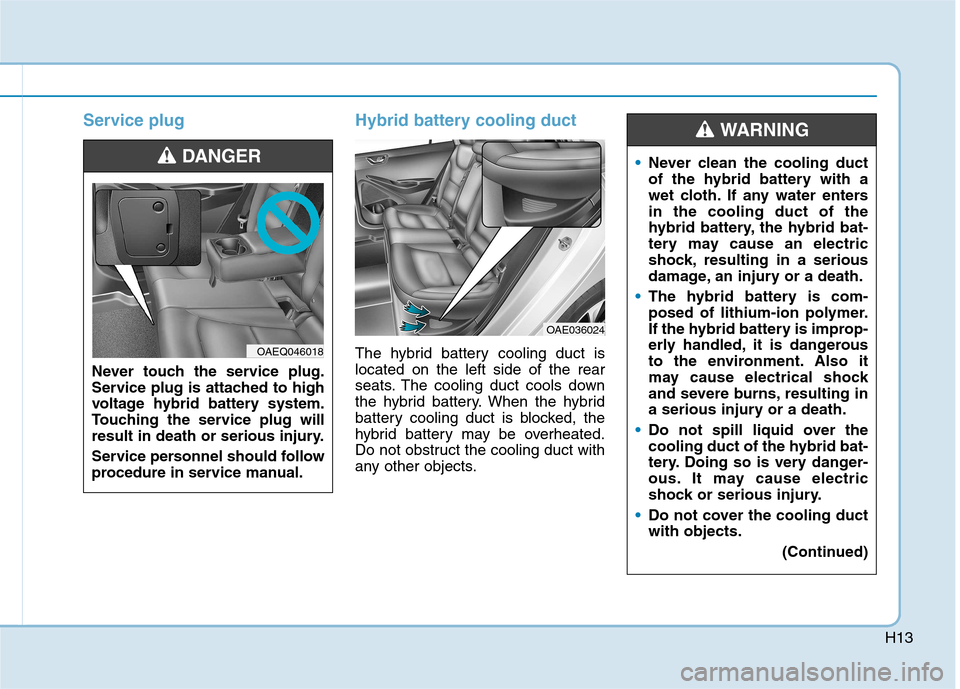
H13
Service plug Hybrid battery cooling duct
The hybrid battery cooling duct is located on the left side of the rear
seats. The cooling duct cools down
the hybrid battery. When the hybrid
battery cooling duct is blocked, the
hybrid battery may be overheated.
Do not obstruct the cooling duct with
any other objects.
Never touch the service plug.
Service plug is attached to high
voltage hybrid battery system.
Touching the service plug will
result in death or serious injury.
Service personnel should follow
procedure in service manual.
DANGER
OAEQ046018
OAE036024
Never clean the cooling duct
of the hybrid battery with a
wet cloth. If any water entersin the cooling duct of the
hybrid battery, the hybrid bat-
tery may cause an electric
shock, resulting in a serious
damage, an injury or a death.
The hybrid battery is com-
posed of lithium-ion polymer.
If the hybrid battery is improp-
erly handled, it is dangerous
to the environment. Also it
may cause electrical shock
and severe burns, resulting in
a serious injury or a death.
Do not spill liquid over the
cooling duct of the hybrid bat-
tery. Doing so is very danger-
ous. It may cause electric
shock or serious injury.
Do not cover the cooling duct with objects.
(Continued)
WARNING
Page 29 of 553
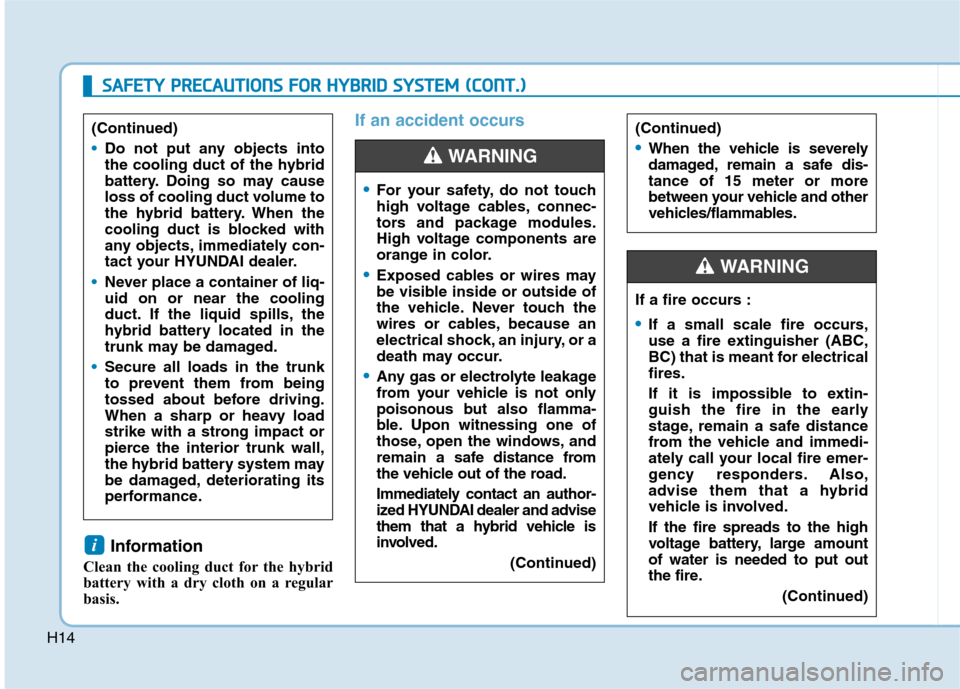
H14
Information
Clean the cooling duct for the hybrid
battery with a dry cloth on a regular
basis.
If an accident occurs
i
(Continued)
Do not put any objects into
the cooling duct of the hybrid
battery. Doing so may cause
loss of cooling duct volume to
the hybrid battery. When the
cooling duct is blocked with
any objects, immediately con-
tact your HYUNDAI dealer.
Never place a container of liq- uid on or near the cooling
duct. If the liquid spills, the
hybrid battery located in the
trunk may be damaged.
Secure all loads in the trunk
to prevent them from being
tossed about before driving.
When a sharp or heavy load
strike with a strong impact or
pierce the interior trunk wall,
the hybrid battery system may
be damaged, deteriorating its
performance.
SS AA FFEE TT YY PP RR EECCAA UU TTIIOO NNSS FF OO RR HH YY BBRRIIDD SS YY SSTT EEMM (( CC OO NNTT..))
For your safety, do not touch
high voltage cables, connec-
tors and package modules.
High voltage components are
orange in color.
Exposed cables or wires may
be visible inside or outside of
the vehicle. Never touch the
wires or cables, because an
electrical shock, an injury, or a
death may occur.
Any gas or electrolyte leakage
from your vehicle is not only
poisonous but also flamma-
ble. Upon witnessing one of
those, open the windows, and
remain a safe distance from
the vehicle out of the road.
Immediately contact an author-
ized HYUNDAI dealer and advise
them that a hybrid vehicle is
involved.
(Continued)
WARNING
(Continued)
When the vehicle is severely
damaged, remain a safe dis-tance of 15 meter or more
between your vehicle and other
vehicles/flammables.
If a fire occurs :
If a small scale fire occurs,
use a fire extinguisher (ABC,
BC) that is meant for electricalfires.
If it is impossible to extin-
guish the fire in the early
stage, remain a safe distance
from the vehicle and immedi-
ately call your local fire emer-
gency responders. Also,
advise them that a hybrid
vehicle is involved. If the fire spreads to the high
voltage battery, large amountof water is needed to put out
the fire.
(Continued)
WARNING
Page 30 of 553
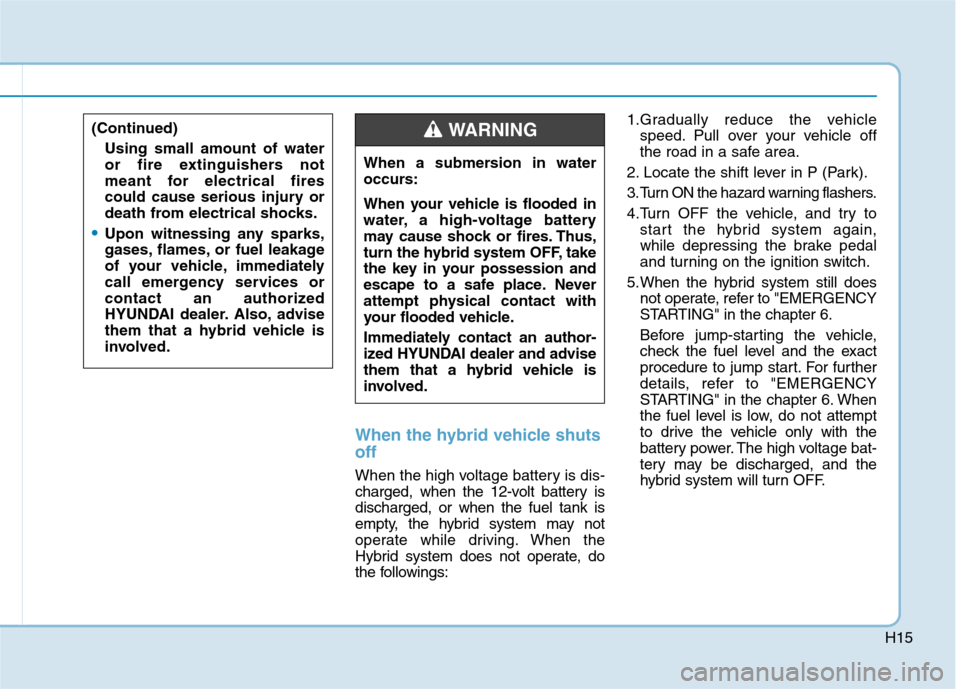
H15
When the hybrid vehicle shuts off
When the high voltage battery is dis-
charged, when the 12-volt battery isdischarged, or when the fuel tank is
empty, the hybrid system may not
operate while driving. When the
Hybrid system does not operate, do
the followings:1.Gradually reduce the vehicle
speed. Pull over your vehicle off
the road in a safe area.
2. Locate the shift lever in P (Park).
3. Turn ON the hazard warning flashers.
4.Turn OFF the vehicle, and try to start the hybrid system again,
while depressing the brake pedal
and turning on the ignition switch.
5.When the hybrid system still does not operate, refer to "EMERGENCY
STARTING" in the chapter 6.
Before jump-starting the vehicle,
check the fuel level and the exact
procedure to jump start. For further
details, refer to "EMERGENCY
STARTING" in the chapter 6. When
the fuel level is low, do not attempt
to drive the vehicle only with the
battery power. The high voltage bat-
tery may be discharged, and the
hybrid system will turn OFF.
(Continued)
Using small amount of water
or fire extinguishers not
meant for electrical fires
could cause serious injury or
death from electrical shocks.
Upon witnessing any sparks,
gases, flames, or fuel leakage
of your vehicle, immediately
call emergency services or
contact an authorized
HYUNDAI dealer. Also, advise
them that a hybrid vehicle is
involved.
When a submersion in water
occurs:
When your vehicle is flooded in
water, a high-voltage battery
may cause shock or fires. Thus,
turn the hybrid system OFF, take
the key in your possession and
escape to a safe place. Never
attempt physical contact with
your flooded vehicle.
Immediately contact an author-
ized HYUNDAI dealer and advise
them that a hybrid vehicle is
involved.
WARNING
Page 149 of 553
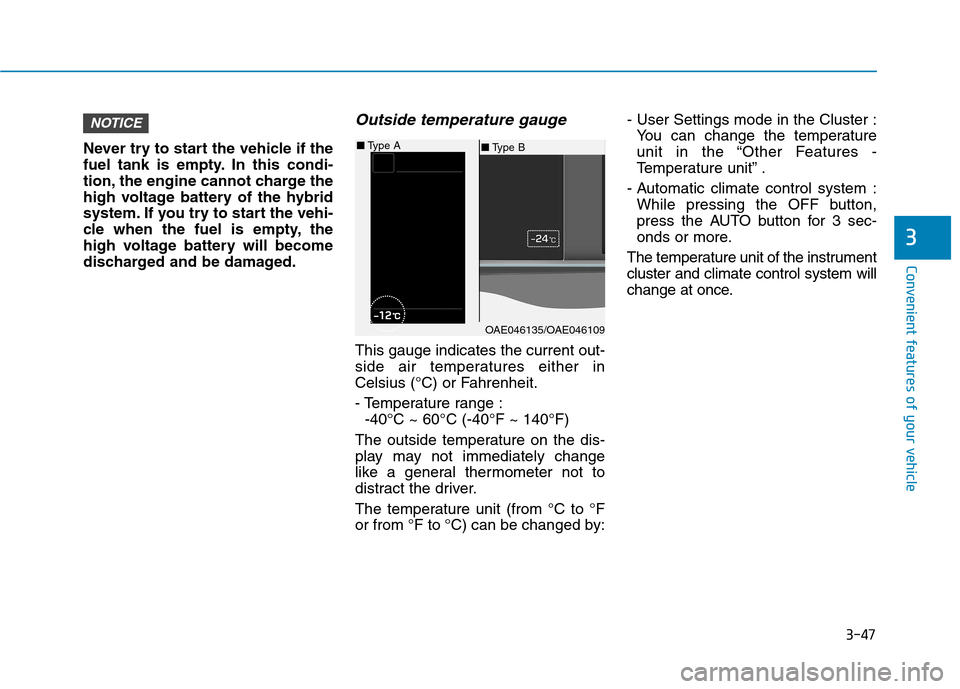
3-47
Convenient features of your vehicle
3
Never try to start the vehicle if the
fuel tank is empty. In this condi-
tion, the engine cannot charge the
high voltage battery of the hybrid
system. If you try to start the vehi-
cle when the fuel is empty, the
high voltage battery will become
discharged and be damaged.
Outside temperature gauge
This gauge indicates the current out-
side air temperatures either in
Celsius (°C) or Fahrenheit.
- Temperature range :-40°C ~ 60°C (-40°F ~ 140°F)
The outside temperature on the dis-
play may not immediately change
like a general thermometer not to
distract the driver.
The temperature unit (from °C to °F
or from °F to °C) can be changed by: - User Settings mode in the Cluster :
You can change the temperature
unit in the “Other Features -
Temperature unit” .
- Automatic climate control system : While pressing the OFF button,
press the AUTO button for 3 sec-
onds or more.
The temperature unit of the instrumentcluster and climate control system will
change at once.
NOTICE
OAE046135/OAE046109
■ Type B
■
Type A
Page 160 of 553
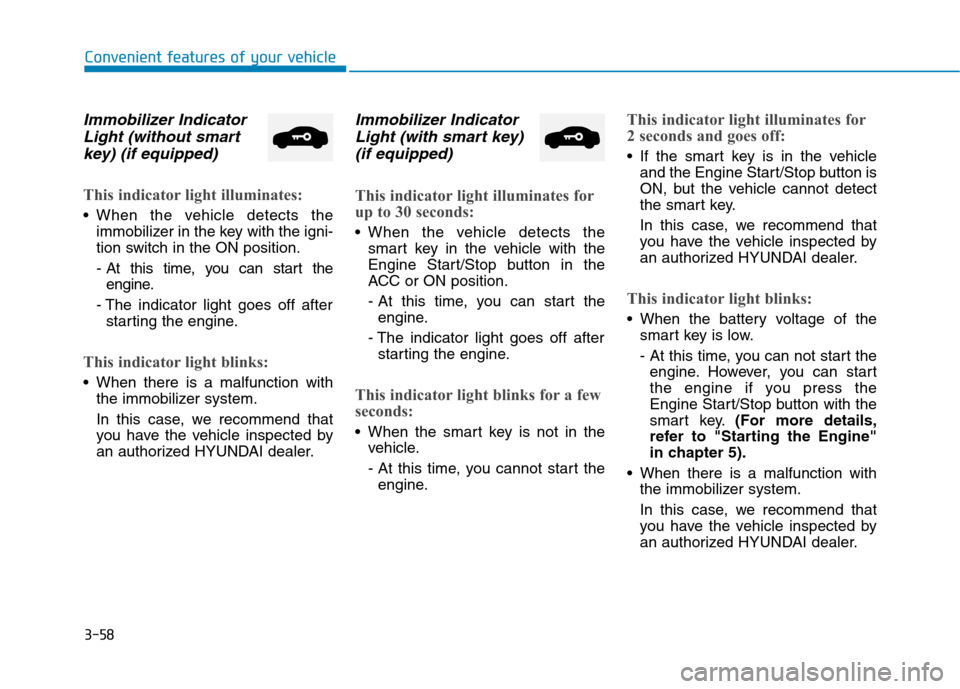
3-58
Convenient features of your vehicle
Immobilizer IndicatorLight (without smart
key) (if equipped)
This indicator light illuminates:
When the vehicle detects the immobilizer in the key with the igni-
tion switch in the ON position.
- At this time, you can start theengine.
- The indicator light goes off after starting the engine.
This indicator light blinks:
When there is a malfunction with the immobilizer system.
In this case, we recommend that
you have the vehicle inspected by
an authorized HYUNDAI dealer.
Immobilizer Indicator
Light (with smart key)
(if equipped)
This indicator light illuminates for
up to 30 seconds:
When the vehicle detects the smart key in the vehicle with the
Engine Start/Stop button in the
ACC or ON position.
- At this time, you can start theengine.
- The indicator light goes off after starting the engine.
This indicator light blinks for a few
seconds:
When the smart key is not in the vehicle.
- At this time, you cannot start theengine.
This indicator light illuminates for
2 seconds and goes off:
If the smart key is in the vehicle and the Engine Start/Stop button is
ON, but the vehicle cannot detect
the smart key.
In this case, we recommend that
you have the vehicle inspected by
an authorized HYUNDAI dealer.
This indicator light blinks:
When the battery voltage of thesmart key is low.
- At this time, you can not start theengine. However, you can start
the engine if you press the
Engine Start/Stop button with the
smart key. (For more details,
refer to "Starting the Engine"
in chapter 5).
When there is a malfunction with the immobilizer system.
In this case, we recommend that
you have the vehicle inspected by
an authorized HYUNDAI dealer.
Page 314 of 553
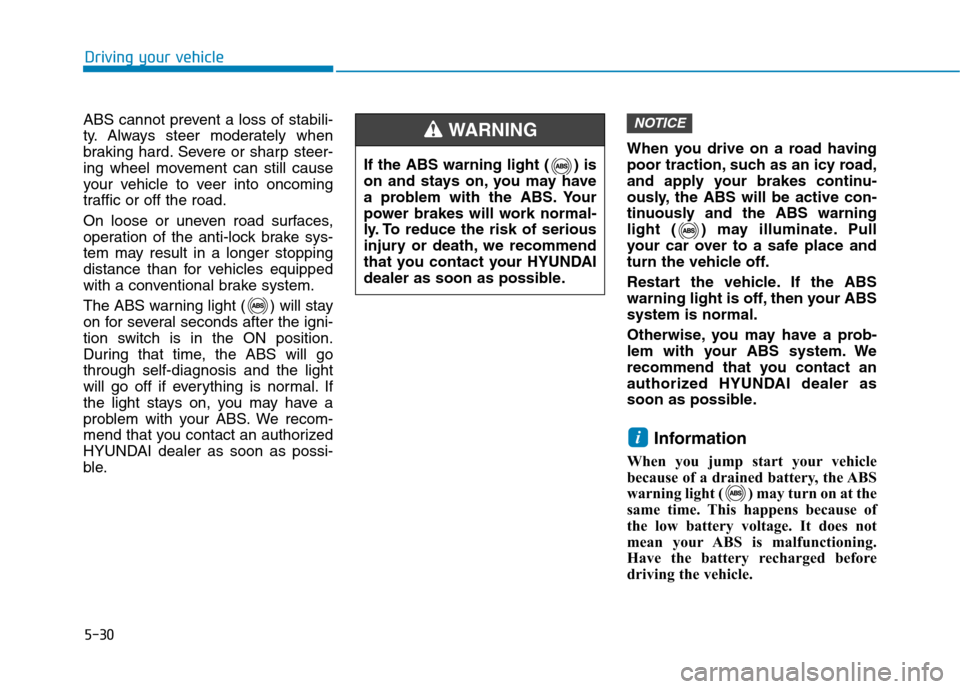
5-30
Driving your vehicle
ABS cannot prevent a loss of stabili-
ty. Always steer moderately when
braking hard. Severe or sharp steer-
ing wheel movement can still cause
your vehicle to veer into oncoming
traffic or off the road.
On loose or uneven road surfaces,
operation of the anti-lock brake sys-
tem may result in a longer stopping
distance than for vehicles equipped
with a conventional brake system.
The ABS warning light ( ) will stay
on for several seconds after the igni-
tion switch is in the ON position.
During that time, the ABS will gothrough self-diagnosis and the light
will go off if everything is normal. If
the light stays on, you may have a
problem with your ABS. We recom-
mend that you contact an authorized
HYUNDAI dealer as soon as possi-
ble.When you drive on a road having
poor traction, such as an icy road,
and apply your brakes continu-
ously, the ABS will be active con-
tinuously and the ABS warning
light ( ) may illuminate. Pull
your car over to a safe place and
turn the vehicle off.
Restart the vehicle. If the ABS
warning light is off, then your ABSsystem is normal.
Otherwise, you may have a prob-
lem with your ABS system. We
recommend that you contact an
authorized HYUNDAI dealer as
soon as possible.
Information
When you jump start your vehicle
because of a drained battery, the ABS
warning light ( ) may turn on at the
same time. This happens because of
the low battery voltage. It does not
mean your ABS is malfunctioning.
Have the battery recharged before
driving the vehicle.
i
NOTICE
If the ABS warning light ( ) is
on and stays on, you may have
a problem with the ABS. Your
power brakes will work normal-
ly. To reduce the risk of serious
injury or death, we recommend
that you contact your HYUNDAI
dealer as soon as possible.
WARNING
Page 390 of 553
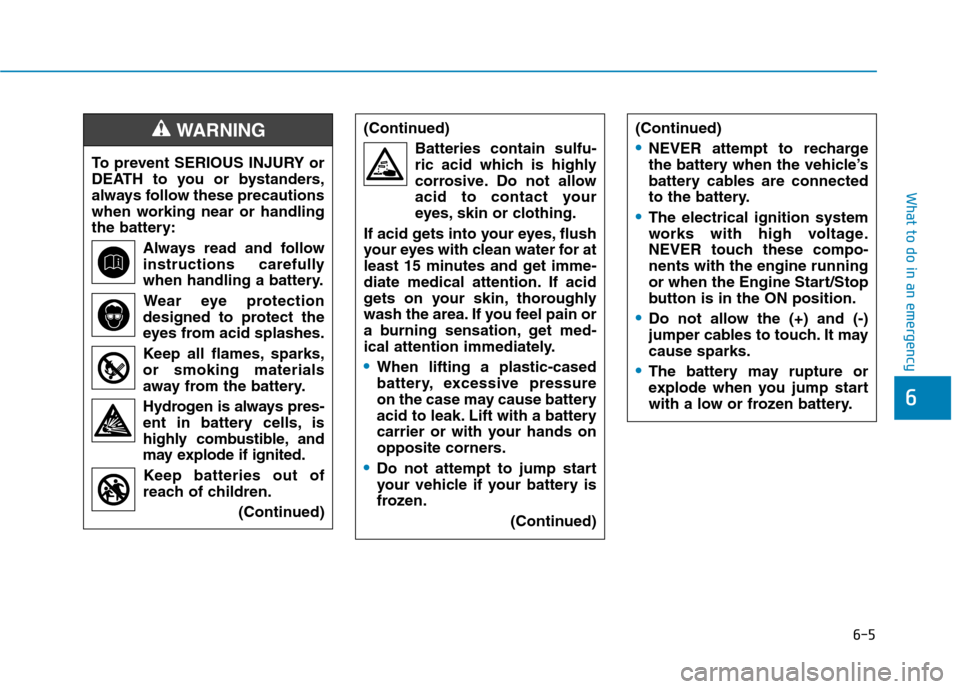
6-5
What to do in an emergency
6
To prevent SERIOUS INJURY or
DEATH to you or bystanders,
always follow these precautions
when working near or handling
the battery:Always read and follow
instructions carefully
when handling a battery.Wear eye protection
designed to protect the
eyes from acid splashes.
Keep all flames, sparks, or smoking materials
away from the battery.
Hydrogen is always pres- ent in battery cells, is
highly combustible, and
may explode if ignited.
Keep batteries out of
reach of children.
(Continued)
(Continued)Batteries contain sulfu-
ric acid which is highly
corrosive. Do not allow
acid to contact your
eyes, skin or clothing.
If acid gets into your eyes, flush
your eyes with clean water for at
least 15 minutes and get imme-
diate medical attention. If acid
gets on your skin, thoroughly
wash the area. If you feel pain or
a burning sensation, get med-
ical attention immediately.
•When lifting a plastic-cased
battery, excessive pressure
on the case may cause battery
acid to leak. Lift with a battery
carrier or with your hands on
opposite corners.
Do not attempt to jump start
your vehicle if your battery is
frozen.
(Continued)
WARNING (Continued)
NEVER attempt to recharge
the battery when the vehicle’s
battery cables are connected
to the battery.
The electrical ignition system
works with high voltage.
NEVER touch these compo-nents with the engine running
or when the Engine Start/Stop
button is in the ON position.
Do not allow the (+) and (-)
jumper cables to touch. It maycause sparks.
The battery may rupture or
explode when you jump start
with a low or frozen battery.
Page 391 of 553
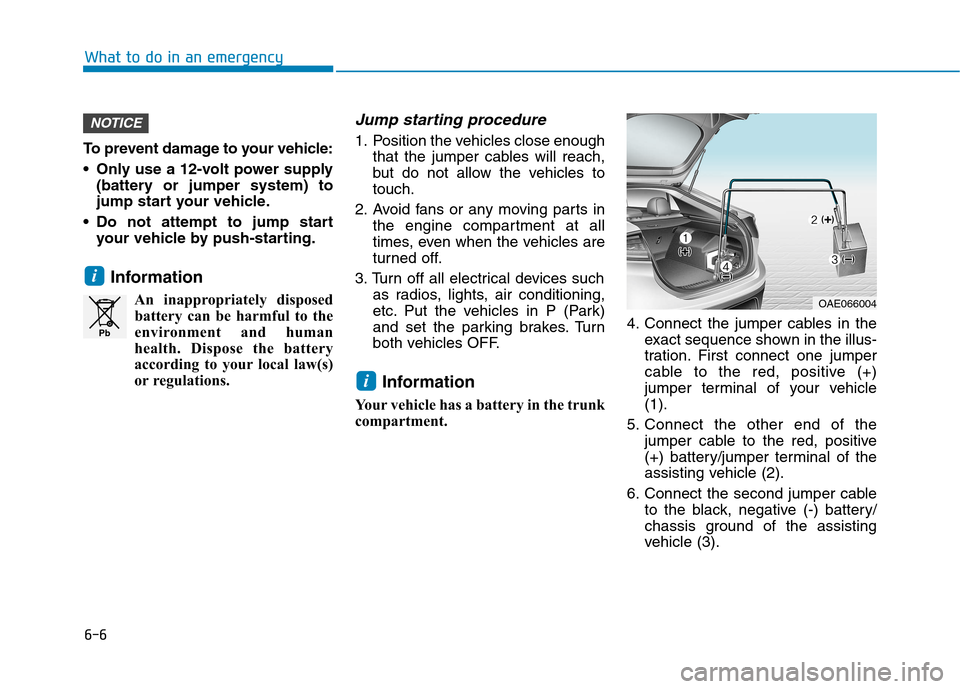
6-6
What to do in an emergency
To prevent damage to your vehicle:
Only use a 12-volt power supply(battery or jumper system) to
jump start your vehicle.
Do not attempt to jump start your vehicle by push-starting.
Information An inappropriately disposedbattery can be harmful to the
environment and human
health. Dispose the battery
according to your local law(s)
or regulations.
Jump starting procedure
1. Position the vehicles close enough that the jumper cables will reach,
but do not allow the vehicles totouch.
2. Avoid fans or any moving parts in the engine compartment at all
times, even when the vehicles are
turned off.
3. Turn off all electrical devices such as radios, lights, air conditioning,
etc. Put the vehicles in P (Park)
and set the parking brakes. Turn
both vehicles OFF.
Information
Your vehicle has a battery in the trunk
compartment. 4. Connect the jumper cables in the
exact sequence shown in the illus-
tration. First connect one jumper
cable to the red, positive (+)
jumper terminal of your vehicle(1).
5. Connect the other end of the jumper cable to the red, positive
(+) battery/jumper terminal of the
assisting vehicle (2).
6. Connect the second jumper cable to the black, negative (-) battery/
chassis ground of the assisting
vehicle (3).
i
i
NOTICE
Pb
OAE066004